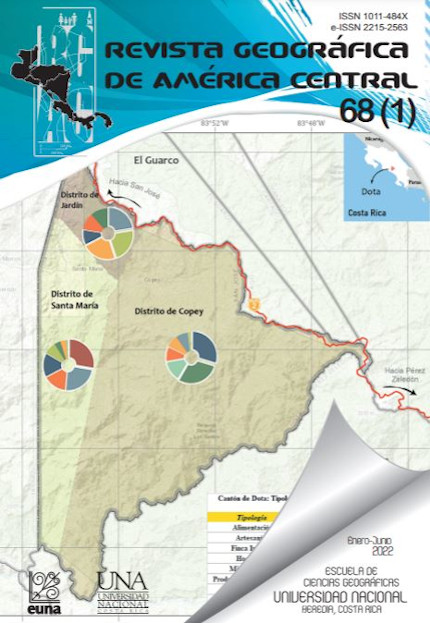Estimation of the surface deformation of the slopes of the Turrialba volcano (Costa Rica) after an eruption using Sentinel-1A differential synthetic aperture radar interferometry (SAR)
DOI:
https://doi.org/10.15359/rgac.68-1.3Keywords:
Remote sensing, Radar, SAR, Interferometry, VolcanismAbstract
Differential synthetic aperture radar interferometry (SAR) is a technique known in remote sensing for its applications in the generation of digital terrain models and the monitoring of deformations of the earth’s crust. This technique is based on the phase, a parameter present in SAR images and sensitive to terrain topography. Phase differences are related to elevation changes that occur between two satellite scans over the same space. To obtain topographic information, a digital terrain model is required and thus, phase differences provide information for estimating vertical terrain displacement to an accuracy greater than 1 centimeter. In the present work it was possible to estimate the surface deformation that occurred on the western slope of the crater of the Turrialba volcano after the eruption of August 1, 2020. For this purpose, several images captured by the Sentinel-1A sensor of the European Space Agency were used.
References
Amelung, F., Galloway, D.L., Bell, J.W., Zebker, H.A., & Laczniak, R.J. (1999). Sensing the ups and downs of Las Vegas: InSAR reveals structural control of land subsidence and aquifer-system deformation. Geology, 27(6), 483-486.
Braun, A. & Veci, L. (2015). Sentinel-1 Toolbox: TOPS Interferometry Tutorial. (2020) SkyWatch Space Applications Inc. European Space Agency. Braun, A. (2019). Radar satellite imagery for humanitarian response. Bridging the gap between technology and application. (Tesis doctoral). Mathematisch-Naturwissenschaftlichen Fakultät der Eberhard Karls Universität, (Tübingen). doi: http://doi.org/10.15496/publikation-32698
Cascini, L., Ferlisi, S., Fornaro, G., Lanari, R., Peduto, D. &Zeni, G. (2006). Subsidence monitoring in Sarno urban area via multi-temporal DInSAR technique. Int. J. Remote Sens, 27(8), 1709-1716.
Chuvieco, E. (2010). Teledetección Ambiental. La observación de la Tierra desde el espacio (3° ed.). Barcelona, España: Ariel Ciencia.
Elachi, C. (1987). Introduction to the Physics and Techniques of Remote Sensing. Chichester, New York, Brisbane, Toronto, Singapore: John Wiley. Geological Magazine, 125(4), 467–467. doi: http://doi.org/10.1017/S0016756800013133
Goldstein, R., Zebker, H., & Werner, C. (1988). Satellite Radar Interferometry: Two-Dimensional Phase Unwrapping. Radio Science, 23(4), 713-720. doi: http://doi.org/10.1029/RS023i004p00713
González, G., Mora-Amador, R., Ramírez Umaña, C., Rouwet, D., Alpízar, Y., Picado, C., & Mora, R. (2015). Actividad histórica y análisis de la amenaza del volcán Turrialba, Costa Rica. Revista Geológica de América Central, (52), 129-149. doi: http://doi.org/10.15517/rgac.v0i52.19033
Guerrero, J. (2008). Dinámica fluvial y riesgos naturales derivados de la subsidencia kárstica en los valles del Huerva y del Ebro. (Tesis doctoral). Universidad de Zaragoza.
Hanssen, R. (2001). Radar Interferometry Data Interpretation and Error Analysis. Kluwer Academic, Dordrecht, Boston. doi: http://doi.org/10.1007/0-306-47633-9
Instituto Meteorológico Nacional de Costa Rica. (2020). Boletín Meteorológico Mensual, agosto 2020.
Herrera, G., Tomás, R., Lopez-Sanchez, J., Monserrat, O., Cooksley, G. & Mulas, J. (2009). Sistemas radar aplicados a la investigación de subsidencia y movimientos de ladera. Enseñanza de las Ciencias de la Tierra, (17.3), 316-324.
Herrera, G., Tomas, R., López-Sánchez, J.M., Delgado, J., Mallorquí, J.J., Duque, S., & Mulas, J. (2007). Advanced DInSAR analysis on mining areas: La Unión case study (Murcia, SE Spain). Eng. Geol. 90(3-4), 148-159.
Jiménez Perálvarez, J. D. (2013). Movimientos de ladera en la vertiente meridional de Sierra Nevada (Granada, España): identificación, análisis y cartografía de susceptibilidad y peligrosidad mediante SIG. (Tesis doctoral). Universidad de Granada, España. Recuperado de: http://hdl.handle.net/10481/23770
Klees, R. & Massonnet, D. (1999). Deformation measurements using SAR interferometry: potential and limitations. Geologie en Mijnbouw 77, 161-176.
Massonnet, D. & Feigl, M. (1998). Radar interferometry and its application to changes in the earth's surface. Review of Geophysics, 36(4): 441-500.
Massonnet, D., Rossi, M., Carmona, C., Adragna, F., Peltzer, G., Feigl, K.& Rabaute, T. (1993). The displacement field of the Landers earthquake mapped by radar interferometry. Nature, 364: 138-142.
Moreira, A., Prats-Iraola, P., Younis, M., Krieger, G., Hajnsek, I. &Papathanassiou, K. (2013). A Tutorial on Synthetic Aperture Radar. IEEE Geoscience and Remote Sensing Magazine (GRSM), 1(1), 6-43. doi: http://doi.org/10.1109/MGRS.2013.2248301
Observatorio Vulcanológico y Sismológico de Costa Rica. (2020). Boletín semanal del Programa de Vigilancia Volcánica del 3 de agosto del 2020. Universidad Nacional de Costa Rica.
Richards M. A., Scheer J. A. & Holm, W. A. (2010). Principles of Modern Radar: Basic Principles. Unites States: SciTech Publishing.
Sigmudsson, F., Durand, P. & Massonnet, D. (1999). Opening of an eruptive fissure and seaward displacement at Piton de la Fournaise volcano measured by Radarsat satellite radar interferometry. Geophys. Res. Lett., 26(5), 533-536.
Siqueira, P. (2019). Forest Stand Height Estimation. SAR Handbook: Comprehensive Methodologies for Forest Monitoring and Biomass Estimation. A. Flores, K. Herndon, R. Thapa, E. Cherrington. (Eds.). E. NASA. doi: http://doi.org/10.25966/4530-7686
Published
How to Cite
Issue
Section
License
Proposed policy for journals offering Open Access
Authors publishing their works in the Journal acknowledge and agree to the following terms:
a) Authors retain the copyrights to their works and guarantee the Journal the right to be the first to publish their works, under the Creative Commons License Attribution-NonCommercial-ShareAlike 4.0 International, CC BY-NC-SA 4.0 International (https://creativecommons.org/licenses/by-nc-sa/4.0/deed.es), which allows others to share works upon complying with the acknowledgment of authorship and mention of the Journal as the original publisher of the work.
b) Authors are permitted to separately establish additional agreements for the non-exclusive distribution of the official edition of the work published in the Journal (for example, authors may desire to place the work in an institutional repository or incorporate it into a book that is to published elsewhere) so long they acknowledgment to recognize the Journal as the original publisher. The aforementioned additional agreements must respect the terms of the non-profit character and sharing philosophy of the original license (CC BY-NC-SA 4.0 International, https://creativecommons.org/licenses/by-nc-sa/4.0/deed.es).
c) Authors are encouraged to archive the post-print or editor/PDF version in Open Access repositories.






 REVGEO is licensed under https://creativecommons.org/licenses/by-nc-sa/4.0/deed.es
REVGEO is licensed under https://creativecommons.org/licenses/by-nc-sa/4.0/deed.es
.svg_4.png)

_(1).png)
_(1)_(1)_(1)_1.png)
(2)(1)(1)(1).png)
